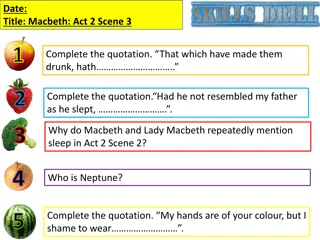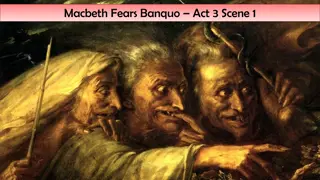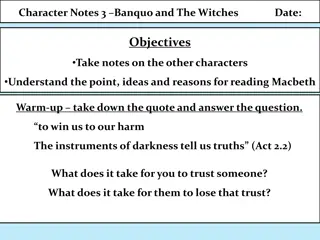Analyzing Macbeth's Internal Struggle in Act 1 Scene 7
Explore Macbeth's inner turmoil and conflicting emotions as he contemplates the idea of killing King Duncan in Act 1 Scene 7 of Shakespeare's play. From his soliloquy to the shocking imagery, delve into the complexities of Macbeth's character and the impact of ambition on his psyche.
Download Presentation

Please find below an Image/Link to download the presentation.
The content on the website is provided AS IS for your information and personal use only. It may not be sold, licensed, or shared on other websites without obtaining consent from the author.If you encounter any issues during the download, it is possible that the publisher has removed the file from their server.
You are allowed to download the files provided on this website for personal or commercial use, subject to the condition that they are used lawfully. All files are the property of their respective owners.
The content on the website is provided AS IS for your information and personal use only. It may not be sold, licensed, or shared on other websites without obtaining consent from the author.
E N D
Presentation Transcript
Macbeth Macbeth Learning Objective Read and understand Act 1 Scene 7 Review Act 1
Starter If it were done when tis done, then twere well It were done quickly. If the assassination Could trammel up the consequence, and catch With his surcease success; that but this blow Might be the be-all and the end-all here, But here, upon this bank and shoal of time, We d jump the life to come. But in these cases We still have judgment here, that we but teach Bloody instructions, which, being taught, return To plague th' inventor: this even-handed justice Commends the ingredients of our poisoned chalice To our own lips. He s here in double trust: First, as I am his kinsman and his subject, Strong both against the deed; then, as his host, Who should against his murderer shut the door, Not bear the knife myself. Besides, this Duncan Hath borne his faculties so meek, hath been So clear in his great office, that his virtues Will plead like angels, trumpet-tongued, against The deep damnation of his taking-off; And pity, like a naked newborn babe, Striding the blast, or heaven s cherubim, horsed Upon the sightless couriers of the air, Shall blow the horrid deed in every eye, That tears shall drown the wind. I have no spur To prick the sides of my intent, but only Vaulting ambition, which o'erleapsitself And falls on th' other. Find the silver bullet word in each line (the word which you think is the most important in that line). Write down each silver bullet word. Look at your collection of 28 words what do these words suggest about Macbeth at this point in the play?
Extension Shakespeare uses monosyllabic words to create tension and drama. He also uses monosyllabic words to show deception and hidden identity. Why do you think this is the case? Find the monosyllabic words in Macbeth s opening soliloquy. How many are there? Why? What does this tell us? Read and perform the soliloquy to your neighbour. Close your eyes and listen to your partner s performance. What do you learn? How does this help?
Act 1 Scene 7 How would you direct this scene? Where would you put Lady Macbeth on the stage? Where would you put Macbeth? Why? Find some examples of the Macbeth s shocking imagery in particular in relation to children and death. What could this imagery suggest about the Macbeths? What does it add to the play?
How are Macbeth and Lady Macbeth presented in Act 1 Scene 7? Macbeth is presented as very troubled by the thought of killing King Duncan in his soliloquy in Act 1 Scene 7. This is illustrated through the opening lines which contain repetition, such as: If it were done when tis done, then twere well it were done quickly. The repetition of the phrase were done three times in quick succession suggests that Macbeth is struggling to control his emotions and is very distressed; he is far from the calm and logical hero that the Shakespearean audience would have expected him to be. Furthermore, it could be argued that were done acts as a euphemism for killing Duncan ; the thought of killing King Duncan is so abhorrent to him that Macbeth cannot even bring himself to speak plainly about it. This sense of turmoil and horror is further shown when he says then twere well it were done quickly . The adverb quickly indicates that Macbeth does not want to dwell over the finer details of the act because it is so terrifying to him.
Macbeth also appears to be worried about upsetting the natural order of the universe in his soliloquy. This is shown through his use of religious imagery: his virtues will plead like angels, trumpet-tongued against the deep damnation of his taking-off. The hyperbole of pleading angels implies that Macbeth thinks the very act of killing King Duncan will cause an outcry in heaven. We associate angels with holiness and innocence. During this period audiences would have been troubled by the thought of regicide (killing of a monarch).
In contrast to her husband, Lady Macbeth is presented as ambitious and determined to see the deed through. This is shown through violent imagery, such as when she freely admits that she would dashed the brains out of a baby she was feeding if she had made a promise like Macbeth; she would not hesitate. This admission and imagery appals us as an audience because of its explicit and graphic nature. Additionally, Shakespeare s audience would have traditionally associated women with gentleness and full of maternal, loving instinct.
Plenary How have characters been represented in this adaptation of Macbeth ? Is this how you pictured the opening of Macbeth? Are you happy with this or unhappy? Why?
Homework Must: Find other monosyllabic words throughout Act 1 Scene 7 and list them. Who uses the most Macbeth or Lady Macbeth? Why? Should: Count ip the monosyllabic words in this scene. Compare this to the amount of monosyllabic words in another scene ( brave Macbeth maybe). How do they compare? Why? Could: Write a paragraph exploring Shakespeare s use of language and its effects on both a modern audience and an Elizabethan one.























